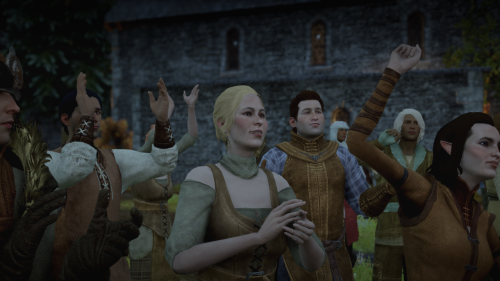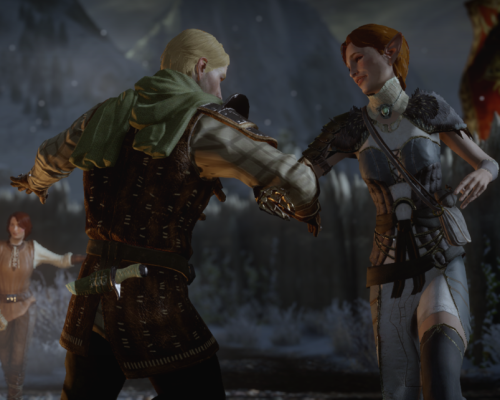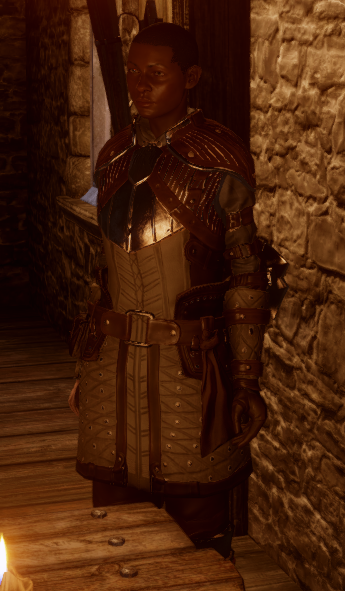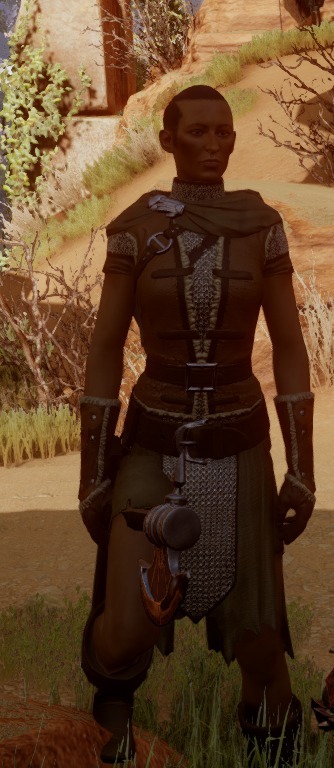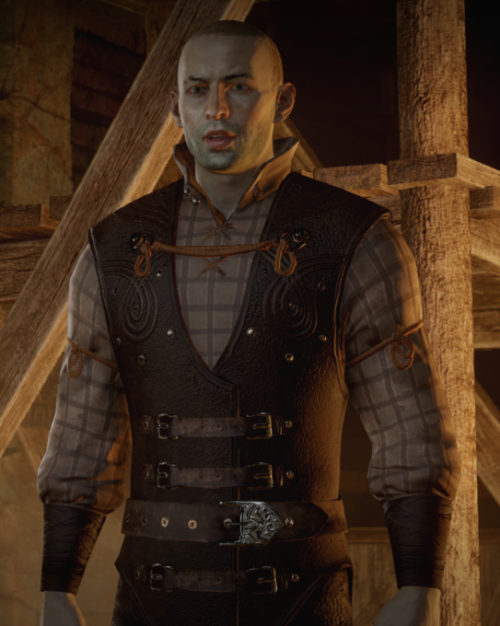Life In Rivain - What We Know Going Into Dragon Age: The Veilguard
Life in Rivain - What We Know Going Into Dragon Age: The Veilguard
For the first time in the game franchise, it has been confirmed that players will get the opportunity to explore Rivain. As such, we will finally be learning a lot more about Rivain upon its release. This piece is about the information we have thus far.

Location & Population
The Kingdom of Rivain, founded in -44 Ancient, is located on the northeastern peninsula of Thedas. Surrounded nearly entirely by water, its only land connection is Antiva.
Those native to Rivain are called Rivaini. Just like any nation in Thedas, there are different racial/ethnic backgrounds who live there – however, the majority of Rivain’s population is Black.
There is also a notable qunari population in Rivain, dating back to when they arrived in Thedas in 6:32 Steel. Kont-aar still exists as a large Qunari settlement in the northern part of the nation – it is regarded as peaceful.
The capital of Rivain is Dairsmuid, which sits on the Rialto Bay. Dairsmuid is the only place in Rivain that has any real Chantry control.
Relations
Because Rivain has a lot of flavour profiles found only in the northern part of Thedas, other nations highly value their food exports. As Rivain is friendly with the Qunari, they are willing to trade in Seheron, too.
Rivain has a “less-than-cordial” relationship with Tevinter. It also has an unserious rivalry with Antiva.
Culture
The Rivaini are traditionally a matriarchal society, believing that women are best suited to rule. Major decisions within a community rest on the head of elder women, who is often a Seer (see: Magic).
Rivain has a currency-based economy. However, there is, generally speaking, a greater value placed in making sure everyone has what they need over monetary gain. For example, if one community has a bad year the neighbouring communities will send supplies and labour to ensure its people do not suffer.
“The Rivaini people trace their roots to pantheist ancestors, and many in Rivain still believe that their god and the universe are one in the same.” —Dragon Age: The World of Thedas vol. 1
Rivain is has the most diverse range of spiritual beliefs in Thedas, because the Chantry failed to become the monopoly like they did everywhere else. The three most common spiritualties are Andrastianism, the Qun, and unnamed traditional Pantheism beliefs.
Daily life for an average citizen of Rivain differs greatly across the nation, because it is such a patchwork of cultures that co-exist in relative peace. Life in Kont-aar for example, is structured by the Qun, where life in a remote village in the southern tip would likely be highly influenced by the Raiders who call Llomerryn home.
Magic
Traditional Rivaini beliefs hold their Seers in high regard. Seers are female mages who specialize in peacefully communicating with spirits and even intentionally invite them into their bodies. They act as wise women and leaders of their communities, for whom people go to for guidance.
Twice a year, the Seers of Rivain gather in Dairsmuid to meet in council, forge trade agreements, and publicly pledge loyalty to Rivain's queen. This is called the Allsmet, and it is a fully celebrated festival with lavish feasts, gift exchanges, ceremonial gatherings, and music.
There was a single Rivaini Circle of Magi, located in Dairsmuid, but it existed largely as a façade to appease the Chantry. Unfortunately, when the Chantry sent Seekers to inspect the Circle in 9:40, they discovered the mages breaking Chantry law. The mages were allowed to freely be with their families, and were training female mages as Seers. The Seekers they invoked the Right of Annulment; they murdered all the mages of the Circle, and destroyed their library of books and artifacts.
Lords of Fortune
The Lords of Fortune are a guild of treasure hunters and dungeoneers, based out of Rivain. They can be identified by the decorations they were all over their body; trinkets they’ve collected over their years of treasure hunting. Sometimes they are hired by others to help out on a job, while other times they seek their own adventure. Anyone of any race can become a Lord of Fortune.
-----
References
Codex entry: Seers and the Allsmet (Dragon Age: Inquisition)
Codex entry: The Annulment at Dairsmuid (Dragon age: Inquisition)
Dragon Age: The World of Thedas vol. 1
Dragon Age: The World of Thedas vol. 2
Dragon Age: Tevinter Nights
-----
Do you enjoy these kinds of posts? Please consider supporting me writing more!
More Posts from Worlds-of-thedas and Others
On the pitfalls of relying on myth and historic, faded strength during an international emergency.
Part 2 of a series of posts talking about the letters my first character received from the Inquisitor during the events of Veilguard, and why I am very excited about them and personally really enjoy what they have to say about the political and strategic situations in the South.
I am going to strongly recommend that you read part 1 first, especially if you find this post in isolation! I go into a lot of context there that sets the stage for this one.
However long this series winds up being, in the final post I will wrap up how I feel the letters tie into the overarching themes of both this game and the series as a whole, and my feelings as a narrative designer on how Bioware used these letters to thread an impossibly small needle. If I make any lore mistakes, my apologies! But I'm mainly going to be talking about strategy and political ramifications here.
So!
The first letter, with a load bearing middle paragraph, told us a lot about the starting position of the South, in particular, of Ferelden and Orlais, during the events of Veilguard.
In that paragraph, it evoked a LOT of history. Both in-world historical events prior to the games, and of our actions within each title.
The second letter, received after the fall of Weisshaupt, is even more densely packed than the first. I'll be presenting it in chunks and going through it bit by bit as a result.

From the title of this letter, it sets the tone. The fall of Weisshaupt, capitalized as The Fall of Weisshaupt, reflecting that this is an event of immediate major consequence in the now and historic record.
Weisshaupt, as a fortress that was constructed in the First Blight, and that has never fallen in all that time, is a location shrouded in legend.
Before we can go through this letter, we need to consider the circumstances in which it was built, and why.
To do that, we need to consider the first Grey Wardens. Per the codex entry from Origins of, The Grey Wardens, the original Wardens were former soldiers of the Tevinter Imperium. Their lived experience had been nothing but endless war and Blight, and they met in the newly constructed Weisshaupt fortress to discuss their options. Per World of Thedas, p. 156, Weisshaupt was built in an area strategically close to Tevinter, but not hit as hard by the Blight.
In a time when the Blight had been an omnipresent reality for 90 years, that's a very significant starting position for a new order to have. They renounced their nationality and political ties.
Weisshaupt becomes their base of operations, and while it is a considerably larger fortress, we can consider it analogous to Skyhold in Inquisition in several ways - both in Inquisition itself and in Veilguard.

Per the codex entry gained in Origins, The First Blight: Chapter 4, one of the first if not THE first major victory the Grey Wardens won was at the city of Nordbotten, circled in the screenshot above.
Reports of each Warden taking down 10-20 Darkspawn at a time - a number that seems almost ludicrously low compared to the expectations on them in current Thedas.
But the first Blight, while very long, also saw the Darkspawn divided heavily between their surface and underground activity. There were less of them overall, and they had to cut their way through the Dwarves in order to establish their underground hives that would allow them to become an exponentially multiplying threat.
Over the next hundred years, the first Wardens fought to establish themselves. They made treaties, they established conscription and did not discriminate by race or class or background. In many ways, their actions mirror those the Dwarves took in creating the first Golems, but that's a subject for a different post, maybe.
All of this builds up to saying:
Weisshaupt was critical as a strategic location when it was first used as a base of operations. That victory cemented it as the ancestral headquarters of the Grey Wardens in all the time that follows, but as time marched on it became less and less strategically relevant to subsequent Blights.
Its main value became symbolic - the last refuge, the place to make a last stand. Weisshaupt has never fallen, and while it remains standing, there is hope.
I am being handed a note. It's this note. We can talk about the rest of this note now.

With all that prior context established, we can look at the actions the First Warden takes here with a critical eye. Leaving aside the merit of some of the things he has to say to Rook in the game, when we consider the actual underlying positions that the First Warden holds, he is deeply conservative, and a hardline traditionalist. He is an old soldier, yes, but as has been seen by references to his actions in previous titles and in this one: he is largely a figurehead, caught up in politicking.
As a political figurehead, but one fully on board with the death-cult tendencies of the modern Wardens (obsession with past glory and future heroic, destined death; deeply secretive to its own organizational detriment; rife with paranoia), First Warden Glastrum is faced with a deeply unenviable burden: constant darkspawn activity and multiple Blights across what we can assume is his entire tenure in the position, since no reference I can find is made to his having been a newcomer to the role.
Already quite old, both by normal standards and ESPECIALLY Warden ones, the First Warden displays some irrational behaviours that made me suspect he was actively experiencing his Calling from our first meeting with him.
His fixation on due process struck me as a desperate attempt to seek control in the face of that, and the actions that followed reinforced my feelings that this was a man who wants to cement his own legacy while he still can.
Calling the Wardens back to Weisshaupt is a strategic choice that does not make sense outside of that framework, and it is reinforced as what is probably going on by the Veilguard codex entry: Every Warden's Journey.

Viewed through this lens, and with him experiencing the Calling later confirmed if you reason with the First Warden, we can see that calling the Wardens back to Weisshaupt was less about meaningfully combatting the new Blight, and more about forcing a last stand.
We know that all the Wardens are having a bad time once Ghilan'nain takes control of the Blight. We know, per Dorian, that the First Warden signed off on the plan to raise a demon army in Inquisition, a plan which involved active collaboration with the Venatori. It is not the first time he has approved Glorious Last Stands.
The First Warden is a perfect target to subvert if you are Elgar'nan and Ghilan'nain, and the Grey Wardens are a potential obstruction to your plans to consolidate control over the entirety of Thedas.
He wants to do right. He wants to fulfill his duty. He wants to die with honor, and make his mark in a way he has not been able too across the rest of the games, trapped as he is in the role of a figurehead.
And so he calls the Wardens, en masse, back to Weisshaupt. And we all know how that goes.
He concentrates them all in one place, which at this time in history, is a strategically useful location, but not for what we see it used for. Not as a border fort with immediate access to the worst off areas in this new Blight.
Weisshaupt would have been the perfect place to house refugees, and to use as a counterpart to Skyhold in the South. An information and logistics center.
Baiting the First Warden into a suicidal last stand serves multiple strategic purposes:
It consolidates the bulk of the Grey Warden order in a single, isolated location.
It pisses off everyone who currently really needs Grey Warden support.
It denies those people and places Grey Warden support, which as we will go over in the letter has devastating consequences.
It denies the forces in the North a powerful base of operations, as just outlined.
A victory at Weisshaupt is a devastating blow to morale across all of Thedas. It's fall robs everyone of the comforting myth that no matter what happens, they can always fall back to Weisshaupt and know that they will be safe. It sends a message: nowhere is outside of our reach, and there is nobody who can protect you.
We see how this unfolds in the next lines of the letter. The Grey Wardens withdraw, and it results in immediate losses of ground, particularly for Orzammar. It is a betrayal of one of the oldest alliances that the Wardens have, and one that will stoke the isolationist tendencies of Orzammar's ruling class.
If they are abandoned, once again, why should they show up for anyone else? And, indeed, I did not hear of them again until the final letter.
Orzammar has been dying a slow death across all of the games. The humans - and then the Qunari, in the events of Trespasser - have been trying to circumvent reliance on the Dwarves for access to the lyrium trade across all of the games and in the historical record.
There is a horrifying mirroring of the true history of the Dwarven people we learn about in the Descent DLC and the things we learn in Veilguard that we can see in these efforts.
And no matter who we made King, Orzammar has up until now refused to adapt and make the systemic change needed to reverse this slide into obliteration: the abolishment of the caste system. I want to go into the differences between Orzammar's approach and that of Kal-Sharok, but that will have to be a different post I think. Suffice it to say, based on everything we have seen of that city in prior titles, I expected exactly this result. Now Orzammar will have to contend with the same set of circumstances that Kal-Sharok was once forced into:

The unaddressed systemic cultural issues and generational trauma of the Dwarves of Orazmmar led to them becoming increasingly isolationist and reliant on the lyrium trade in order to tend to their daily needs. And without Grey Warden allies, and with their supply lines also affected by the same issues hitting Ferelden, their options dwindle sharply.
And a thousand or so Wardens die at Weisshaupt.
That is a devastating loss. We see what even a pair of Grey Wardens can do multiple times across the series.

With the loss of the Wardens and Weisshaupt both, Ghilan'nain and Elgar'nan can launch the next stage of their offensives. Remembering that aside from being known as the mother of the halla, Ghil is the elven goddess of guides and navigation. We can subsequently intuit that she probably has a very firm understanding of how long it takes to get places, and she has control of the Blight and the Darkspawn - which means she now controls the Deep Roads near entirely unopposed. She's got the subway.
Coordinating an eruption of Darkspawn at historic sites terrorizes Thedas with what the Dwarves already knew: the Darkspawn are everywhere, in seething hordes, and surfacers will reckon with those numbers when Orzammar no longer holds them back.
So!

Per the last letter, the border with Orlais is being harried. The Darkspawn horde at Ostagar appears to have made directly for Denerim - another strong strategic move. Take out the capital, and theoretically you undermine the ability of the nation to organize and field meaningful resistance. Except, here, the less centralized structure of Ferelden society does it a firm favour. As we have seen in prior games, Denerim is not the only key location to locking Ferelden down. Redcliffe is also critical. I'm being handed another note, but that's a problem for future me and for future Ferelden.
The situation in the capital is grim, yes, but not currently totally lost. We have seen how stubborn and determined the people of Denerim are in the face of adversity in Origins firsthand.
Next up is the one part of this that I did not see coming after receiving the first letter - though I should have! I overlooked the implications of the Jaws of Hakkon dlc, having only viewed it through for the first time shortly before Veilguard's release.

When the political process is failing, when the establishments are tearing themselves apart, when civilians lives are on the line and there is an existential threat to everyone: the sorely neglected and othered often step up to provide the most critical support. So it is here, with the Chasind and the Avvar.
Relegated to the margins across all of the games, treated mostly by our viewpoint characters and those we interact with as backward and provincial at best, both the Chasind and the Avvar are substantial and mostly unrepresented groups in the franchise. They also occupy the most outwardly 'hostile' terrain in Ferelden, and know it like the back of their hands.
I got so, so excited when this popped up. The implications of this alliance were the most stirring thing to give me hope for the South. With access to the travel routes and supply lines, as well as remote and well protected territories, the potential to slip civilians out from the noose that Elgar'nan and Ghilan'nain are tightening around Ferelden shoots up.
Troops can be moved, and so long as the Blight is contained and harried at by those who at this point have a great deal of learned experience fighting Darkspawn, this alliance marks a potential turning point both in the immediate moment we receive the letter, and in the long-term arc of history that will go on far past the events of the game itself.
It's exciting to me, and I'm excited to also dig into the next letter! As with the last one, nobody else has to like what they've done here, but I think it's great, and I'm really excited to share more of why.
Avvar lore resources
I might be a little bit invested in a certain part of Dragon Age lore...
Jaws of Hakkon DLC transcript - a transcript of all dialogue lines from JoH DLC, including variations dependent on the Inquisitor's race, previous choices, and quest order.
Avvar history reconstruction - a 7-part series delineating the history of the Avvar tribe
Avvar first names spreadsheet - a thorough list of Avvar first names that appear in canon sources, organized by their real-life origin if possible
Avvar name structure - a detailed analysis of how Avvar names are constructed, including first names, surnames, legend-marks, and clan names
Avvar symbolism - collages of visual symbols related to the Lady of the Skies, Hakkon Wintersbreath, Korth the Mountain-Father
Parallels between Korth and the Titans
Elven roots of the word "Avvar"
Random bits of Avvar lore
can i say, as i'm playing the veilgaurd, i really enjoy how every game varric's in he has a completely different relationship with each protagonist (not really spoilery under the cut but read at ur own risk)
in da2, him and hawke are BESTIES. they match each other's wit. they flirt (female hawke). they get each other into boatloads of trouble and always get each other out of it. varric never left hawkes side no matter what hawke said or did. they were equals.
in dai with him and the inquisitor, it always seemed like he held the inquisitor just a little bit at arm's length. yes, he was their friend and a part of their inner circle, but he always made it a point to mention that the inquisitor is "larger than life" and is more of a figure of legend than a person. he always gave advice the best he could, but obviously what would he know about being a "herald of andraste". they were not equals, at least if you asked varric.
in datv, he is clearly rook's mentor. any chance you get, he is always hyping up rook's abilities and leadership. making jokes if their feeling on edge. making sure they never doubt themselves. literally, any time you visit him where he's healing, he always has some real SWEET thing to say to you "are you sleeping?" "make sure you rest" "you got this kid". with varric, rook can be vulnerable. "if i hadn't made that choice, neve/harding wouldn't've gotten hurt" and varric makes sure you understand that that wasn't your fault and had to make a choice. they were not equals, at least if you asked rook. but varric would disagree.
(obviously i'm not done playing VG so idk if how i'm interpreting this is accurate BUT ALAS)
i appreciate how varric is seen differently in each game he's in, it makes him always really interesting to watch throughout each game!
what is the walls of darkrown made of? wood?
Thinking about the mage rebellion and Fereldan. My main Warden is a Surana that sticks Alistair with the throne so I never really gave it much thought about why Ferelden's ruler would accept the rebellion.
But I replayed and something stuck out to me: Connor was frustrated about them being in Redcliffe. He asks how that could be seen to be a good idea. And honestly? Given that the Wardens rule Amaranthine and it's a major point of entry from the sea it wouldn't be that hard to have set Fiona's people there and gotten fewer side eyes by the locals. They're used to Wardens, mages ain't that weird in comparison. Especially after the Warden-Commander let a possessed corpse follow them home from the swamp like a lost mabari.
But Ferelden has a population problem. Lots of dead young men and women just at Ostagar, let alone the southern hills, the bannorn via the rebellion, and Denerim. And the survivors of the Siege at Denerim would have had high chances of Blight Sicknesses, there were probably epidemics following 9:31. That would have crippled the fighting population. That doesn't even count that a lot of the refugees who made it to the Marches and elsewhere never returned.
Redcliffe is the fortified gateway to Ferelden from the /Orlesian/ border. The same Orlais that certain powers (Gaspard) want to return to being an expanding empire.
Celene's hold was weak. Weak enough the Inquisitor could arrange to break it entirely.
The Chantry is primarily Orlesian and that would give the mages a reason to not want Orlesian control if it came down to Gaspard as Emperor bringing chevaliers back across the Frostbacks.
I don't think Ferelden took the mages in out of generosity. At least not entirely. I think they saw a chance to add a significant military force to their country if their gamble paid off - and that's why Teagan agreed. Unfortunately for the rebellion the Tevinter thing is a definite point of no return - the mages weren't loyal enough to their own cause, to where they were, to continue the risk of keeping them.





three fools does not make a wise man i fear


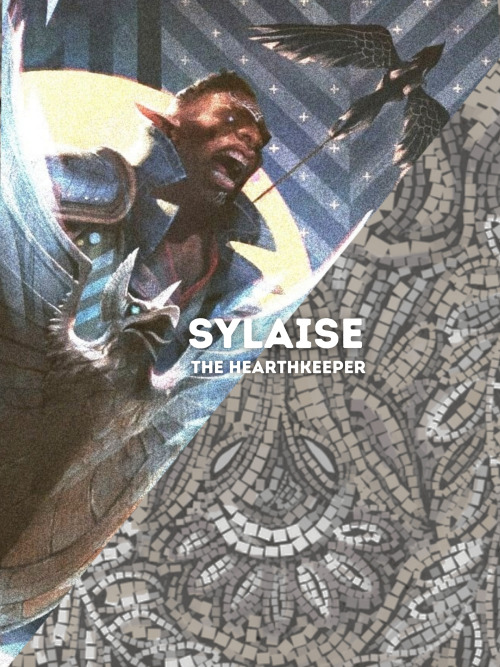




It is calming to see something familiar in another
inspo x x
One of the craziest things about Dragon Age (and this might help those of you who don’t go here kind of understand what people are yelling about in the coming months) is its lore. But I don’t mean that in the way you’re probably thinking.
I mean, quite literally, the way it presents its lore to you. In picking up notes and books as you go along and sifting through the codex, the game effectively asks you to act as an anthropologist. You’re met with a host of primary and secondary sources, some many hundreds of years apart from one another, written by anyone from the highest Chantry scholar to John Farmer, and you’re meant to constantly be questioning every piece of information you’re given. What biases are present in what I’m reading? What is fact and what is complete fabrication and what is, potentially, a slightly twisted version of a fact? How does one source potentially contradict another? The lore is one giant mystery-puzzle that you get to piece together across three games, and what conclusions you draw are going to be entirely different from someone else’s, and so on.
And yet, the series still does something even cooler than any of that. You realize, at a certain point, that this idea you have been engaging with on a meta-level — this idea that history is biased and fallible, that it’s written by colonizers and conquerers, genocidal racists and religious zealots, that the ability to control historical narrative is the prize you win for spilling the most blood — that idea is one of, if not perhaps THE most important, overarching theme of the series. The way that we remember history — what we remember and what we don’t, and why — and the impact that has on people on a sociological, political, cultural and psychological level, on both a macro and micro scale. It’s the entire thesis of the series’ main villain’s whole motivation.
And there’s gonna be a lot of people that don’t care about all that but me personally it makes me want to gnaw on a cinder block and scratch at my walls
Anyway here's the Guerrin timeline as best I can piece it together, if it's useful to anyone!
Updated 7/14/23 with corrections & additions.
~8:84 Blessed - Eamon is born. (The Calling - He's 15 at the time of the Battle of West Hill, which occurred in 8:99 Blessed.)
8:99 Blessed - The Battle of West Hill. Arl Rendorn Guerrin, Eamon's father, is killed in action. Maric Theirin is presumed dead but reappears in Gwaren, which is then taken by the rebels. The Battle of River Dane deals a decisive defeat to the Orlesian forces, though the conflict is not completely over. It will take several more years to completely drive out the occupying lords. However, Emperor Florian officially withdraws support for King Meghren.
9:02 Dragon - Eamon, 18, returns to Redcliffe to claim his place as arl, but find it still under Orlesian control, and works with the rebel forces to reclaim it. Isolde, the daughter of one of the Orlesian governors, is sympathetic to the rebels and becomes infatuated with Eamon, who does not return her feelings; nevertheless, she feeds information to the rebels, and chooses to stay in Ferelden after her family is driven out. Isolde is four years younger than Eamon, making her 14 at the time. (WoT v.2 p. 102, 106)
9:02 Dragon - Maric kills the usurper King Meghren in a dual, officially ending the occupation and winning Ferelden's freedom. (There is a noted discrepancy in the dates between the epilogue of The Stolen Throne, and World of Thedas vol. 1, the latter of which puts the duel at 9:00 Dragon. Given other events, the later date seems more plausible.)
~9:08 Dragon - Six years after their initial meeting, Eamon (24) meets Isolde (20) again in Denerim. They quickly become involved and are married. (WoT v.2 p. 103)
9:10 - Alistair is born to Fiona and King Maric. His parents give him up to be raised at Redcliffe Castle, inventing a story about his mother being a human serving girl. (The Calling.)
~9:20 Dragon - Isolde becomes pregnant with Connor after difficulty conceiving. This causes rumors about Alistair (10) being Eamon's bastard to resurface, and Eamon sends him away to a monastery to spare his wife's feelings. Connor is born soon after.
~9:29 Dragon - Short of taking his vows as a templar, Alistair (19) is conscripted into the Grey Wardens. (WoT v.2 p.79)
~9:30 Dragon - Connor Guerrin (10) shows signs of magic. Isolde hires an apostate, Jowan, to tutor Connor in secret. Eamon (46) is poisoned by Jowan and falls ill. (Origins.)
~9:31 Dragon - Following the Blight, Eamon decides to stay in Denerim, serving as an advisor to the throne, eventually declaring his brother Teagan the new Arl of Redcliffe. (Origins, WoT v.2 p.104)
?:?? Dragon - (If Connor is dead) Rowan Guerrin is born to Isolde and Eamon. After a difficult birthing, Isolde dies. (Potential Origins Epilogue slide.)
?:?? Dragon - Rowan Guerrin shows signs of magic and is sent to the Circle, though her father continues to visit her. (Potential Origins Epilogue slide.)
-
 redpandahero liked this · 1 week ago
redpandahero liked this · 1 week ago -
 animecreepystuff1621-blog reblogged this · 2 weeks ago
animecreepystuff1621-blog reblogged this · 2 weeks ago -
 animecreepystuff1621-blog liked this · 3 weeks ago
animecreepystuff1621-blog liked this · 3 weeks ago -
 iridescentcobalt liked this · 1 month ago
iridescentcobalt liked this · 1 month ago -
 ambroselaveau90 liked this · 2 months ago
ambroselaveau90 liked this · 2 months ago -
 krogans-give-the-best-cuddles liked this · 4 months ago
krogans-give-the-best-cuddles liked this · 4 months ago -
 cyrulen liked this · 4 months ago
cyrulen liked this · 4 months ago -
 andromedasummer reblogged this · 5 months ago
andromedasummer reblogged this · 5 months ago -
 andromedasummer liked this · 5 months ago
andromedasummer liked this · 5 months ago -
 behira-the-bard liked this · 5 months ago
behira-the-bard liked this · 5 months ago -
 mycactusisjustdead liked this · 5 months ago
mycactusisjustdead liked this · 5 months ago -
 lgvalenzuela reblogged this · 6 months ago
lgvalenzuela reblogged this · 6 months ago -
 mitsubishiskeets liked this · 6 months ago
mitsubishiskeets liked this · 6 months ago -
 synthtosix liked this · 6 months ago
synthtosix liked this · 6 months ago -
 heraexmachina liked this · 6 months ago
heraexmachina liked this · 6 months ago -
 taashyvashedan reblogged this · 6 months ago
taashyvashedan reblogged this · 6 months ago -
 imperator-kahlo reblogged this · 6 months ago
imperator-kahlo reblogged this · 6 months ago -
 warspider liked this · 6 months ago
warspider liked this · 6 months ago -
 firsthumandisaster liked this · 6 months ago
firsthumandisaster liked this · 6 months ago -
 everythings-onfirebut-itsfine liked this · 7 months ago
everythings-onfirebut-itsfine liked this · 7 months ago -
 tidyassassin liked this · 7 months ago
tidyassassin liked this · 7 months ago -
 chrysalisuspirii liked this · 7 months ago
chrysalisuspirii liked this · 7 months ago -
 ilikethingssoapy-blog liked this · 7 months ago
ilikethingssoapy-blog liked this · 7 months ago -
 wherearethemang0s liked this · 7 months ago
wherearethemang0s liked this · 7 months ago -
 devi1lute liked this · 7 months ago
devi1lute liked this · 7 months ago -
 merrill-was-right reblogged this · 8 months ago
merrill-was-right reblogged this · 8 months ago -
 fimrila liked this · 8 months ago
fimrila liked this · 8 months ago -
 thatrandomfeministgamer liked this · 8 months ago
thatrandomfeministgamer liked this · 8 months ago -
 kcwriter-blog liked this · 8 months ago
kcwriter-blog liked this · 8 months ago -
 wickedapostate reblogged this · 8 months ago
wickedapostate reblogged this · 8 months ago -
 honeyochii reblogged this · 8 months ago
honeyochii reblogged this · 8 months ago -
 honeyochii liked this · 8 months ago
honeyochii liked this · 8 months ago -
 blackwalls reblogged this · 8 months ago
blackwalls reblogged this · 8 months ago -
 scribeofstories reblogged this · 8 months ago
scribeofstories reblogged this · 8 months ago -
 april0rain liked this · 8 months ago
april0rain liked this · 8 months ago -
 megaosoperezoso liked this · 8 months ago
megaosoperezoso liked this · 8 months ago -
 ventures-through-thedas reblogged this · 9 months ago
ventures-through-thedas reblogged this · 9 months ago -
 jampocalypse liked this · 11 months ago
jampocalypse liked this · 11 months ago -
 dragonageinsanity reblogged this · 11 months ago
dragonageinsanity reblogged this · 11 months ago -
 calicostorms reblogged this · 11 months ago
calicostorms reblogged this · 11 months ago -
 butchofthewilds reblogged this · 11 months ago
butchofthewilds reblogged this · 11 months ago -
 odogarons reblogged this · 11 months ago
odogarons reblogged this · 11 months ago -
 saintdagger liked this · 11 months ago
saintdagger liked this · 11 months ago -
 salemsreblogs reblogged this · 11 months ago
salemsreblogs reblogged this · 11 months ago -
 salemcantupdate liked this · 11 months ago
salemcantupdate liked this · 11 months ago -
 emorstrador liked this · 11 months ago
emorstrador liked this · 11 months ago -
 tj14tg liked this · 11 months ago
tj14tg liked this · 11 months ago -
 faylock liked this · 11 months ago
faylock liked this · 11 months ago -
 aansaas reblogged this · 11 months ago
aansaas reblogged this · 11 months ago

A collection of canonical and non-canonical lore of Thedas, and archive of the amazing meta this fandom has produced. All work will be properly sourced and any use of other's work should conform to their requests. (icon made by @dalishious)
72 posts
